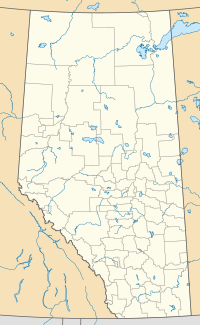Scandia, Alberta
Scandia | |
|---|---|
 Last remaining prairie grain elevator in the Scandia district. | |
| Coordinates: 50°16′41″N 112°02′48″W / 50.27806°N 112.04667°W | |
| Country | Canada |
| Province | Alberta |
| Region | Southern Alberta |
| Census division | 2 |
| Municipal district | County of Newell |
| Government | |
| • Governing body | County of Newell Council |
| Area (2021)[1] | |
| • Land | 0.19 km2 (0.07 sq mi) |
| Population (2021)[1] | |
• Total | 169 |
| • Density | 877.9/km2 (2,274/sq mi) |
| Time zone | UTC−7 (MST) |
| • Summer (DST) | UTC−6 (MDT) |
| Postal code span | |
| Area code | +1-403 |
| Highways | Highway 36 |
Scandia is a hamlet in Alberta, Canada within the County of Newell.[2] It is located 2 kilometres (1.2 mi) west of Highway 36, approximately 34 kilometres (21 mi) southwest of Brooks.
History
[edit]The 23.4 mile Cassils Southerly Branch of the Canadian Pacific Railway was built from Cassils to Scandia in 1927–1928.[3]
Demographics
[edit]| Year | Pop. | ±% |
|---|---|---|
| 1941 | 30 | — |
| 1951 | 64 | +113.3% |
| 1956 | 64 | +0.0% |
| 1961 | 51 | −20.3% |
| 1966 | 45 | −11.8% |
| 1971 | 34 | −24.4% |
| 1976 | 38 | +11.8% |
| 1981 | 79 | +107.9% |
| 1986 | 113 | +43.0% |
| 1991 | 115 | +1.8% |
| 1991A | 116 | +0.9% |
| 1996 | 119 | +2.6% |
| 2001 | 114 | −4.2% |
| 2006 | 137 | +20.2% |
| 2011 | 154 | +12.4% |
| 2016 | 146 | −5.2% |
| 2021 | 169 | +15.8% |
| Source: Statistics Canada [4][5][6][7][8][9][10][11][12][13][14][15][16][17][1] | ||
In the 2021 Census of Population conducted by Statistics Canada, Scandia had a population of 169 living in 52 of its 56 total private dwellings, a change of 15.8% from its 2016 population of 146. With a land area of 0.19 km2 (0.073 sq mi), it had a population density of 889.5/km2 (2,303.7/sq mi) in 2021.[1]
The population of Scandia according to the 2020 municipal census conducted by the County of Newell is 169.[18]
As a designated place in the 2016 Census of Population conducted by Statistics Canada, Scandia had a population of 146 living in 43 of its 54 total private dwellings, a change of -5.2% from its 2011 population of 154. With a land area of 0.19 km2 (0.073 sq mi), it had a population density of 768.4/km2 (1,990.2/sq mi) in 2016.[17]
Attractions
[edit]See also
[edit]- List of communities in Alberta
- List of designated places in Alberta
- List of hamlets in Alberta
- List of museums in Alberta
- List of provincial historic sites of Alberta
References
[edit]- ^ a b c d "Population and dwelling counts: Canada and designated places". Statistics Canada. February 9, 2022. Retrieved February 10, 2022.
- ^ "Specialized and Rural Municipalities and Their Communities" (PDF). Alberta Municipal Affairs. June 3, 2024. Retrieved June 14, 2024.
- ^ Grain and Rail in Western Canada Canada. Grain Handling and Transportation Commission - 1977 0660010143 "CP Rail - Cassils Subdivision - From Cassils to Scandia, Alberta - 23.4 miles This line was constructed in 1928. The rail is a mixture of 60 and 85 pound steel with a gross carrying capacity of 177 thousand pounds. There are no elevators on"
- ^ Ninth Census of Canada, 1951 (PDF). Vol. SP-7 (Population: Unincorporated villages and hamlets). Dominion Bureau of Statistics. March 31, 1954. Retrieved September 22, 2024.
- ^ Census of Canada, 1956 (PDF). Vol. Population of unincorporated villages and settlements. Dominion Bureau of Statistics. October 25, 1957. Retrieved September 23, 2024.
- ^ 1961 Census of Canada: Population (PDF). Series SP: Unincorporated Villages. Vol. Bulletin SP—4. Ottawa: Dominion Bureau of Statistics. April 18, 1963. Retrieved September 25, 2024.
- ^ Census of Canada 1966: Population (PDF). Special Bulletin: Unincorporated Places. Vol. Bulletin S–3. Ottawa: Dominion Bureau of Statistics. 1968. Retrieved September 25, 2024.
- ^ 1971 Census of Canada: Population (PDF). Special Bulletin: Unincorporated Settlements. Vol. Bulletin SP—1. Ottawa: Statistics Canada. 1973. Retrieved September 25, 2024.
- ^ "Geographical Identification and Population for Unincorporated Places of 25 persons and over, 1971 and 1976". 1976 Census of Canada (PDF). Supplementary Bulletins: Geographic and Demographic (Population of Unincorporated Places—Canada). Vol. Bulletin 8SG.1. Ottawa: Statistics Canada. 1978. Retrieved September 26, 2024.
- ^ 1981 Census of Canada (PDF). Place name reference list. Vol. Western provinces and the Territories. Ottawa: Statistics Canada. 1983. Retrieved September 26, 2024.
- ^ 1986 Census of Canada (PDF). Population. Vol. Unincorporated Places. Ottawa: Statistics Canada. 1988. Retrieved September 26, 2024.
- ^ 91 Census (PDF). Population and Dwelling Counts. Vol. Unincorporated Places. Ottawa: Statistics Canada. 1993. Retrieved September 26, 2024.
- ^ 96 Census (PDF). A National Overivew: Population and Dwelling Counts. Ottawa: Statistics Canada. 1997. Retrieved September 26, 2024.
- ^ "Population and Dwelling Counts, for Canada, Provinces and Territories, and Census Divisions, 2001 and 1996 Censuses - 100% Data (Alberta)". Statistics Canada. August 15, 2012. Retrieved September 19, 2024.
- ^ "Population and dwelling counts, for Canada, provinces and territories, and designated places, 2006 and 2001 censuses - 100% data (Alberta)". Statistics Canada. July 20, 2021. Retrieved September 19, 2024.
- ^ "Population and dwelling counts, for Canada, provinces and territories, and designated places, 2011 and 2006 censuses (Alberta)". Statistics Canada. February 8, 2012. Retrieved September 19, 2024.
- ^ a b "Population and dwelling counts, for Canada, provinces and territories, and designated places, 2016 and 2011 censuses – 100% data (Alberta)". Statistics Canada. February 8, 2017. Retrieved February 13, 2017.
- ^ "Municipal Census Report 2020". County of Newell. p. 3. Retrieved September 25, 2021.
- ^ Scandia Eastern Irrigation District Museum.

